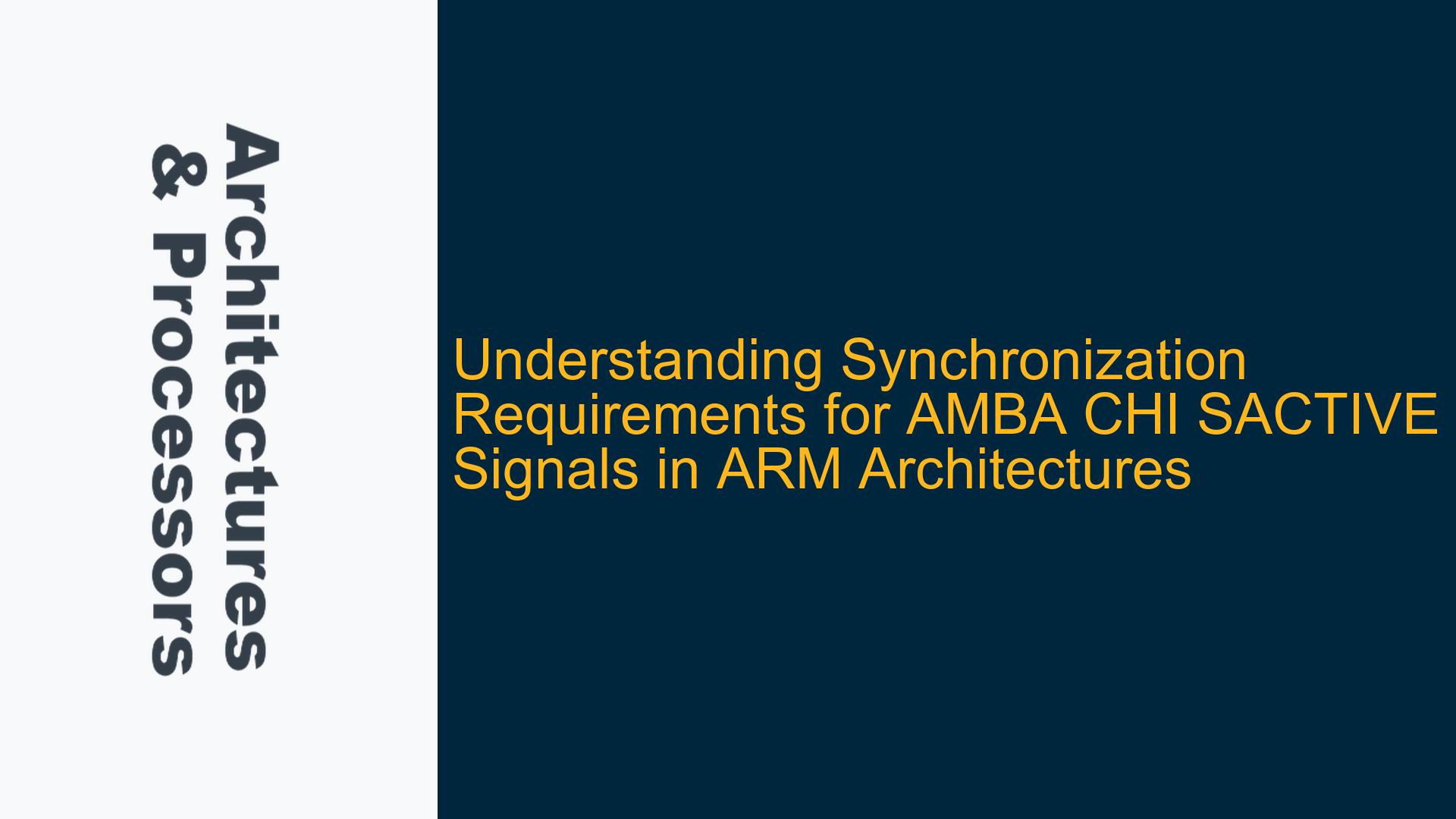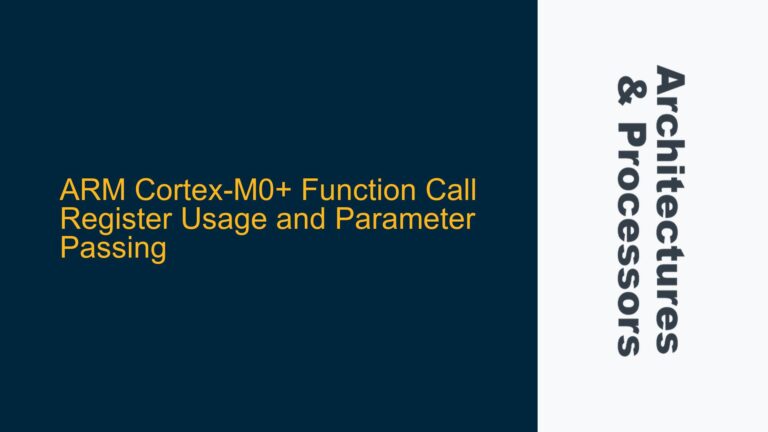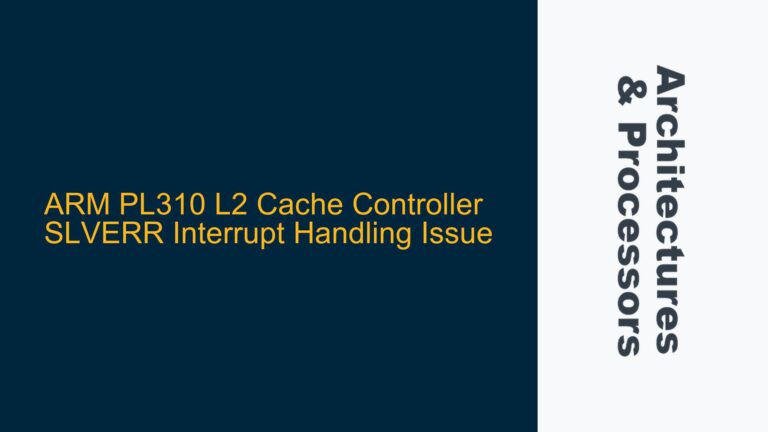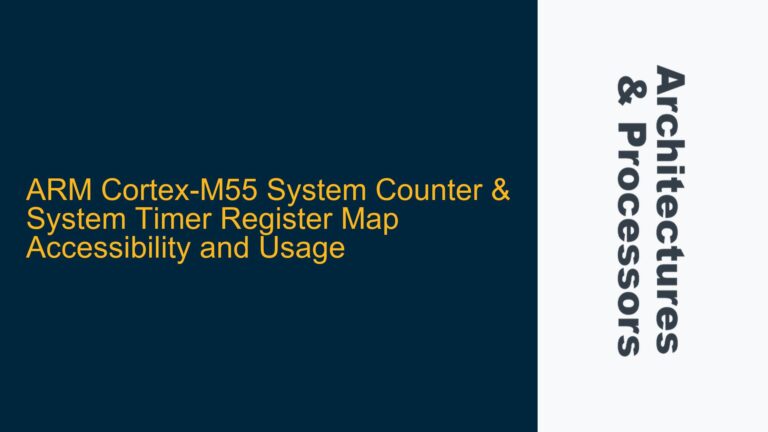SACTIVE Signal Synchronization and Timing Requirements in AMBA CHI
The SACTIVE signal in the AMBA CHI (Coherent Hub Interface) protocol plays a critical role in ensuring proper transaction handling and synchronization between components in a system-on-chip (SoC). According to the AMBA CHI Architecture Specification (IHI0050), the SACTIVE signal must be synchronous to the clock (CLK) and does not require additional synchronization if it remains within the same clock domain. However, when the SACTIVE signal crosses clock domains, a clock domain crossing (CDC) bridge must handle the synchronization. The specification emphasizes that the SACTIVE signal must align with the FLITs (Flow Control Units) in terms of timing, but the exact interpretation of "synchronous" in this context can be ambiguous.
The term "synchronous" in the specification refers to the requirement that the SACTIVE signal must be generated and sampled in alignment with the clock edges of the CLK signal. This ensures that the signal is stable and predictable during the transaction lifecycle. However, the specification does not explicitly state whether the SACTIVE signal must be cycle-accurate with respect to the FLITs or if it merely needs to be stable within the same clock domain. This ambiguity can lead to implementation challenges, particularly in systems where the SACTIVE signal traverses multiple clock domains or interfaces with components operating at different frequencies.
The timing requirements for the SACTIVE signal are further clarified by the following rules:
- TXSACTIVE must be asserted before or in the same cycle as the first FLIT of a transaction.
- TXSACTIVE must remain asserted until after the last FLIT of all related transactions is sent or received.
These rules ensure that the SACTIVE signal accurately reflects the state of ongoing transactions and prevents premature deassertion, which could lead to data corruption or incomplete transactions. However, the interaction between the SACTIVE signal and FLITs, especially in multi-clock-domain systems, requires careful consideration to avoid timing violations and ensure reliable operation.
Misalignment Between SACTIVE and FLITs Due to Clock Domain Crossing
One of the primary causes of issues with the SACTIVE signal is misalignment between the signal and the FLITs when crossing clock domains. In a single-clock-domain system, the SACTIVE signal is inherently synchronized with the FLITs because both are driven by the same clock. However, in multi-clock-domain systems, the SACTIVE signal may experience skew or delay when crossing clock boundaries, leading to misalignment with the FLITs.
The AMBA CHI specification mandates that any clock domain crossing involving the SACTIVE signal must be handled by a CDC bridge, which ensures proper synchronization. However, the implementation of the CDC bridge can introduce latency, which may cause the SACTIVE signal to be delayed relative to the FLITs. This delay can result in the SACTIVE signal being deasserted before the last FLIT of a transaction is processed, violating the timing requirements and causing transaction errors.
Another potential cause of misalignment is the improper handling of metastability during clock domain crossing. Metastability occurs when a signal is sampled near the clock edge, leading to unpredictable behavior. While CDC bridges typically include synchronizers to mitigate metastability, these synchronizers can introduce additional latency and exacerbate the misalignment between the SACTIVE signal and the FLITs.
In addition to clock domain crossing issues, the SACTIVE signal may also be affected by variations in clock frequency and phase between different domains. For example, if the source and destination clock domains have slightly different frequencies, the SACTIVE signal may drift over time, leading to cumulative misalignment with the FLITs. This drift can be particularly problematic in systems with long-duration transactions or high data rates.
Implementing Robust Clock Domain Crossing and Synchronization for SACTIVE Signals
To address the challenges associated with SACTIVE signal synchronization and timing, designers must implement robust clock domain crossing mechanisms and adhere to the AMBA CHI specification’s requirements. The following steps outline a comprehensive approach to ensuring reliable operation of the SACTIVE signal in multi-clock-domain systems:
-
Use a Dedicated CDC Bridge for SACTIVE Signal Synchronization: A CDC bridge specifically designed for the SACTIVE signal should be implemented to handle clock domain crossing. This bridge must include synchronizers to mitigate metastability and ensure that the SACTIVE signal is properly aligned with the destination clock domain. The bridge should also account for any latency introduced by the synchronization process to prevent premature deassertion of the SACTIVE signal.
-
Ensure Proper Timing Relationship Between SACTIVE and FLITs: The timing requirements for the SACTIVE signal must be strictly followed to prevent transaction errors. This includes asserting TXSACTIVE before or in the same cycle as the first FLIT of a transaction and maintaining the assertion until after the last FLIT is processed. Designers should use timing analysis tools to verify that these requirements are met under all operating conditions, including variations in clock frequency and phase.
-
Minimize Latency in the CDC Bridge: To reduce the risk of misalignment between the SACTIVE signal and the FLITs, the latency introduced by the CDC bridge should be minimized. This can be achieved by optimizing the synchronizer design and using high-performance clock domain crossing techniques, such as dual-clock FIFOs or handshake protocols. Additionally, the CDC bridge should be placed as close as possible to the source of the SACTIVE signal to minimize signal propagation delay.
-
Perform Comprehensive Timing and Functional Verification: Thorough verification is essential to ensure that the SACTIVE signal operates correctly in multi-clock-domain systems. This includes static timing analysis to verify setup and hold times, as well as functional simulation to validate the behavior of the SACTIVE signal under various scenarios. Designers should also perform corner-case analysis to identify and address potential issues related to clock skew, jitter, and frequency variations.
-
Monitor and Debug SACTIVE Signal Behavior in Real-Time: In complex systems, real-time monitoring and debugging of the SACTIVE signal can provide valuable insights into its behavior and help identify potential issues. This can be achieved using on-chip debug tools, such as trace buffers or logic analyzers, which allow designers to capture and analyze the SACTIVE signal and related FLITs during system operation. Real-time monitoring can also help detect and diagnose issues related to clock domain crossing and synchronization.
By following these steps, designers can ensure that the SACTIVE signal is properly synchronized and aligned with the FLITs, even in multi-clock-domain systems. This not only prevents transaction errors but also enhances the overall reliability and performance of the system.
Advanced Techniques for Handling SACTIVE Signal Synchronization
In addition to the basic steps outlined above, several advanced techniques can be employed to further improve the handling of the SACTIVE signal in complex systems:
-
Adaptive Synchronization: Adaptive synchronization techniques dynamically adjust the synchronization process based on the observed behavior of the SACTIVE signal and the FLITs. For example, if the SACTIVE signal is consistently delayed relative to the FLITs, the synchronization logic can introduce a compensating delay to restore alignment. Adaptive synchronization can be particularly effective in systems with variable clock frequencies or high levels of clock jitter.
-
Predictive Assertion and Deassertion: Predictive techniques use historical data and statistical models to predict the timing of the SACTIVE signal and adjust its assertion and deassertion accordingly. For example, if the system typically processes a certain number of FLITs within a specific time window, the SACTIVE signal can be deasserted slightly earlier to account for any anticipated delays. Predictive techniques require accurate modeling and calibration but can significantly reduce the risk of timing violations.
-
Redundant Synchronization Paths: In critical systems, redundant synchronization paths can be implemented to provide fault tolerance and improve reliability. For example, multiple CDC bridges can be used to synchronize the SACTIVE signal, with a voting mechanism to select the correct value in case of discrepancies. Redundant synchronization paths increase design complexity and resource usage but can be justified in safety-critical applications.
-
Clock Domain Crossing Optimization: Advanced clock domain crossing techniques, such as phase-locked loops (PLLs) or delay-locked loops (DLLs), can be used to align the source and destination clock domains more precisely. These techniques reduce the need for extensive synchronization logic and minimize the latency introduced by the CDC bridge. However, they require careful design and tuning to ensure stable operation.
-
Formal Verification: Formal verification methods can be used to mathematically prove the correctness of the SACTIVE signal synchronization logic. This involves creating a formal model of the synchronization process and using automated tools to verify that the model adheres to the AMBA CHI specification’s requirements. Formal verification is particularly useful for identifying subtle timing issues that may not be detected through simulation or testing.
By leveraging these advanced techniques, designers can further enhance the robustness and reliability of the SACTIVE signal synchronization process, ensuring that it operates correctly even in the most challenging system configurations.
Conclusion
The SACTIVE signal in the AMBA CHI protocol is a critical component for ensuring proper transaction handling and synchronization in ARM-based systems. However, its synchronization and timing requirements can be challenging to implement, particularly in multi-clock-domain systems. By understanding the underlying issues, identifying potential causes of misalignment, and following a comprehensive approach to synchronization and timing, designers can ensure that the SACTIVE signal operates reliably and efficiently. Advanced techniques, such as adaptive synchronization, predictive assertion, and formal verification, can further enhance the robustness of the synchronization process, making it suitable for even the most complex and demanding applications.






